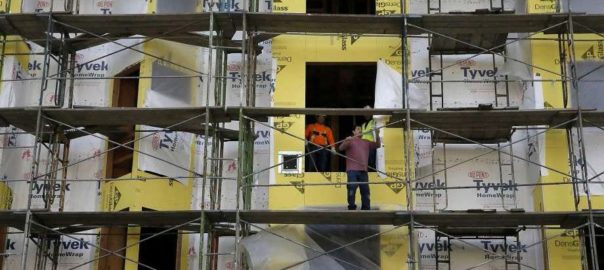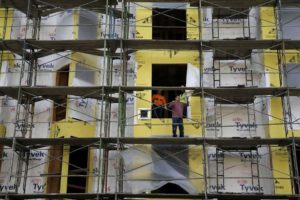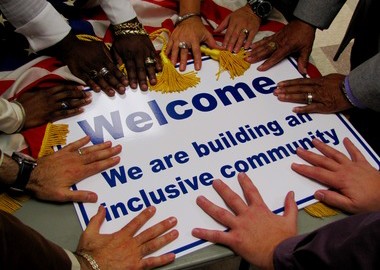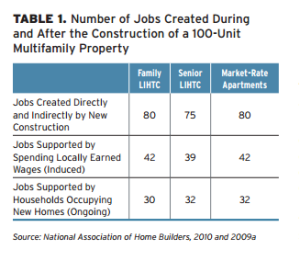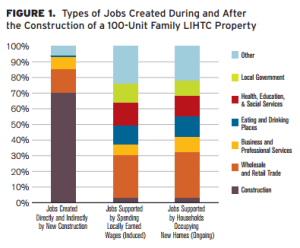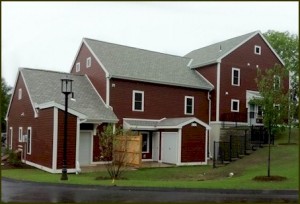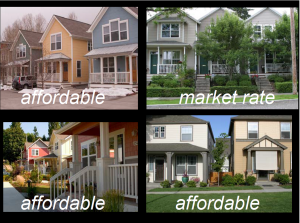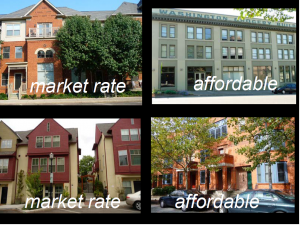From the “Shelterforce Blog”, “Rooflines”
Posted in Shelterforce by Amy Clark on December 14, 2016
http://www.rooflines.org/4710/fighting_community_opposition_in_the_age_ofopposition/ via @Shelterforce
On Nov, 8, voters across the country heard the affordable housing call and approved numerous state and local housing funding measures that will make it possible for more of our neighbors to live in safe, healthy, and affordable homes. This was a real achievement in housing advocacy, but the work is far from over. Developers, local governments, and advocates must now move to convince the neighbors of proposed housing developments to accept more affordable homes into their communities.
The election that brought over 37 affordable housing measures to the ballot in eight states also elevated toxic rhetoric about people of color and other populations. The public discourse has changed, and that’s likely to affect our efforts to build support for affordable housing development and counter community opposition. Here’s what you may hear about affordable housing in your community, and how to prepare for it:
Racial animus. In the wake of the election, there have been many reports of hate-based harassment and intimidation across the country. An offending segment of our population feels newly empowered to use racist language in all types of situations. While racism and fear of difference have always been, at the very least, an undercurrent of some forms of community opposition, in recent years it’s largely been implied, not overt. You may see an uptick in overt racism in siting conversations.
What to do? While it would be satisfying—and, arguably, right—to call out racist language directly when you hear it, research tells us that this is likely to backfire, causing the speaker to defensively double-down on the prejudiced belief. Instead, a study this year found that “a short conversation encouraging actively taking the perspective of others can markedly reduce prejudice.” It argues for holding small-group conversations and facilitators trained to listen and find common ground.
Misinformation. You’ve likely heard much about the success of fake news during the presidential campaign. Misinformation this election cycle may have had a distinctive rightward bent, but don’t pat yourself on the back if you lean left. All of us are susceptible to information that confirms what we already believe, regardless of its factual accuracy. Don’t be surprised to see an increase in the misinformation about your work being posted online and handed around in anonymous flyers around the neighborhoods where you work.
What to do? Don’t write up a “frequently asked questions” page correcting the lies being told about your work. By emphasizing the misinformation—even when you later correct it—you’re just driving it deeper into peoples’ consciousness. Instead, first tell your truth (“Our apartments increase neighborhood safety.”), then signpost the misinformation and explain the motive behind it (“There is a myth circulating that affordable housing increases crime, promoted by a small new neighborhood group formed to fight our proposal.”), and finally give a brief, clear alternative explanation, repeated in graphics if possible (“In fact, by starting a neighborhood watch program and installing security cameras, we’ve helped create a 13 percent decrease in property crime in another neighborhood where we work. We want to work with you to have a similar positive impact here.”).
Ideological conflict. Research into persistent opposition to affordable housing has shown that spatial ideology—an individual’s set of beliefs around who can live in and use a particular place, and who has the right to participate in decision-making about a place—can be predictive of opposition to, or support of, affordable housing. The recent push to disenfranchise groups of Americans through voter ID laws and other restrictions is an example of a narrow conception of spatial rights, and the electoral contest was rife with rhetoric supporting a conscribed idea of to whom America truly belongs. Opposition may now more frequently focus on delegitimizing prospective low-income residents, perhaps as “not American” or simply “not from here.”
What to do? Unfortunately, ideology might be hard-wired, and thus addressing spatial ideology head-on might not be effective. At the same time, there are likely to be people in your community who believe lower-income people have an equal right to live in a place. Find these potential supporters by emphasizing the values of diversity and inclusion, and give this group a clear way to take action and vocalize support of your work.
Distrust of institutional authority. The success of populist presidential candidates from both parties points to, among other things, Americans’ growing distrust of institutions. Whether it’s in banks, the news media, or government itself, people across the political spectrum have lost faith. Unfortunately, affordable housing development connects to all sorts of things many of our neighbors have come to doubt: taxation, finance systems and entities, and zoning, just to name a few.
What to do? First, people who have lost trust will hear a developer mention “partnering with the government” and translate that into an attempt to paper over a profit-making arrangement. Step away from the marketing talk and use plain language to explain what you do, and why it is successful. Second, reframe the role of these perceived-suspect institutions. A new paper from Enterprise Community Partners and the FrameWorks Institute recommends that we help people understand the role of government in affordable housing by explaining, “the role of systems in shaping outcomes for people and … communities,” and by, “zooming out” to tell broader stories that explain the impact of housing issues on an entire community. You know your work is about more than simply units; help others understand this too.
Countering community opposition has never been easy, and I hope to hear that these predictions have not come true, but even if they do, our work can have a long-term impact on decreasing bias. There is evidence that white people living in diverse neighborhoods “endorsed fewer negative stereotypes, and [feel] closer to Blacks as a group.” When we create diverse, inclusive communities, we help decrease prejudice and division. That’s something truly worth fighting for.
